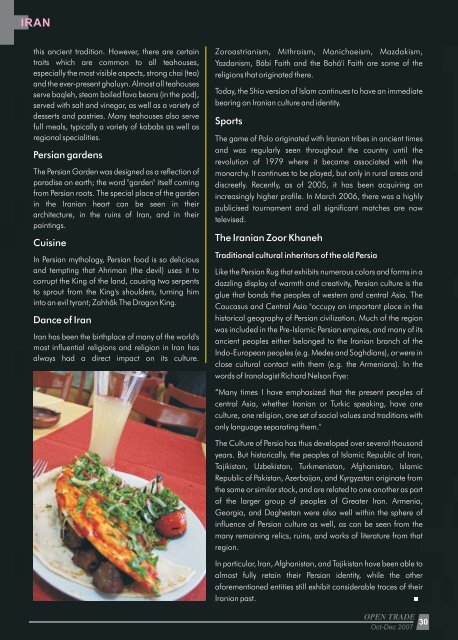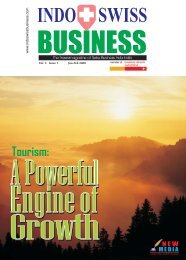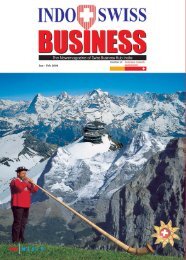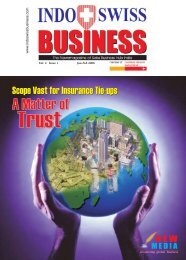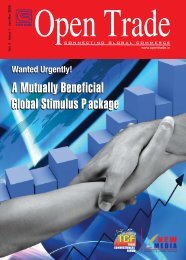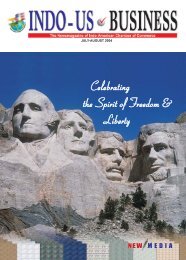pele SciaSction - new media
pele SciaSction - new media
pele SciaSction - new media
Create successful ePaper yourself
Turn your PDF publications into a flip-book with our unique Google optimized e-Paper software.
IRAN<br />
this ancient tradition. However, there are certain Zoroastrianism, Mithraism, Manichaeism, Mazdakism,<br />
traits which are common to all teahouses, Yazdanism, Bábí Faith and the Bahá'í Faith are some of the<br />
especially the most visible aspects, strong chai (tea) religions that originated there.<br />
and the ever-present ghaluyn. Almost all teahouses<br />
serve baqleh, steam boiled fava beans (in the pod),<br />
Today, the Shia version of Islam continues to have an im<strong>media</strong>te<br />
served with salt and vinegar, as well as a variety of bearing on Iranian culture and identity.<br />
desserts and pastries. Many teahouses also serve<br />
full meals, typically a variety of kababs as well as<br />
Sports<br />
regional specialities.<br />
The game of Polo originated with Iranian tribes in ancient times<br />
and was regularly seen throughout the country until the<br />
Persian gardens<br />
revolution of 1979 where it became associated with the<br />
The Persian Garden was designed as a reflection of monarchy. It continues to be played, but only in rural areas and<br />
paradise on earth; the word "garden" itself coming discreetly. Recently, as of 2005, it has been acquiring an<br />
from Persian roots. The special place of the garden increasingly higher profile. In March 2006, there was a highly<br />
in the Iranian heart can be seen in their<br />
publicised tournament and all significant matches are now<br />
architecture, in the ruins of Iran, and in their<br />
televised.<br />
paintings.<br />
Cuisine<br />
The Iranian Zoor Khaneh<br />
In Persian mythology, Persian food is so delicious<br />
Traditional cultural inheritors of the old Persia<br />
and tempting that Ahriman (the devil) uses it to Like the Persian Rug that exhibits numerous colors and forms in a<br />
corrupt the King of the land, causing two serpents dazzling display of warmth and creativity, Persian culture is the<br />
to sprout from the King's shoulders, turning him glue that bonds the peoples of western and central Asia. The<br />
into an evil tyrant; Zahhâk The Dragon King.<br />
Caucasus and Central Asia "occupy an important place in the<br />
Dance of Iran<br />
historical geography of Persian civilization. Much of the region<br />
was included in the Pre-Islamic Persian empires, and many of its<br />
Iran has been the birthplace of many of the world's<br />
ancient peoples either belonged to the Iranian branch of the<br />
most influential religions and religion in Iran has<br />
Indo-European peoples (e.g. Medes and Soghdians), or were in<br />
always had a direct impact on its culture.<br />
close cultural contact with them (e.g. the Armenians). In the<br />
words of Iranologist Richard Nelson Frye:<br />
“Many times I have emphasized that the present peoples of<br />
central Asia, whether Iranian or Turkic speaking, have one<br />
culture, one religion, one set of social values and traditions with<br />
only language separating them."<br />
The Culture of Persia has thus developed over several thousand<br />
years. But historically, the peoples of Islamic Republic of Iran,<br />
Tajikistan, Uzbekistan, Turkmenistan, Afghanistan, Islamic<br />
Republic of Pakistan, Azerbaijan, and Kyrgyzstan originate from<br />
the same or similar stock, and are related to one another as part<br />
of the larger group of peoples of Greater Iran. Armenia,<br />
Georgia, and Daghestan were also well within the sphere of<br />
influence of Persian culture as well, as can be seen from the<br />
many remaining relics, ruins, and works of literature from that<br />
region.<br />
In particular, Iran, Afghanistan, and Tajikistan have been able to<br />
almost fully retain their Persian identity, while the other<br />
aforementioned entities still exhibit considerable traces of their<br />
Iranian past.<br />
<br />
OPEN TRADE 30<br />
Oct-Dec 2007


